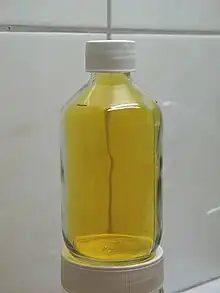Bromine monochloride
 | |
 | |
 | |
| Names | |
|---|---|
| Other names
bromine(I) chloride bromochloride bromine chloride | |
| Identifiers | |
CAS Number |
|
3D model (JSmol) |
|
| ChemSpider | |
| ECHA InfoCard | 100.034.169 |
| EC Number |
|
PubChem CID |
|
| RTECS number |
|
| UNII | |
| UN number | 2901 |
CompTox Dashboard (EPA) |
|
InChI
| |
SMILES
| |
| Properties | |
Chemical formula |
BrCl |
| Molar mass | 115.357 g/mol |
| Appearance | golden yellow gas |
| Density | 2.172 g/cm3 |
| Melting point | −54 °C (−65 °F; 219 K) |
| Boiling point | 5 °C (41 °F; 278 K) |
| Solubility in water | 8.5 g/L |
| Hazards | |
| NFPA 704 (fire diamond) | |
Except where otherwise noted, data are given for materials in their standard state (at 25 °C [77 °F], 100 kPa).
Infobox references | |
Bromine monochloride, also called bromine(I) chloride, bromochloride, and bromine chloride, is an interhalogen inorganic compound with chemical formula BrCl. It is a very reactive golden yellow gas with boiling point 5 °C and melting point −66 °C. Its CAS number is 13863-41-7, and its EINECS number is 237-601-4.[1] It is a strong oxidizing agent. Its molecular structure in the gas phase was determined by microwave spectroscopy; the Br-Cl bond has a length of re = 2.1360376(18) Å.[2] Its crystal structure was determined by single crystal X-ray diffraction; the bond length in the solid state is 2.179(2) Å and the shortest intermolecular interaction is r(Cl···Br) = 3.145(2) Å.[3]
Uses
Bromine monochloride is used in analytical chemistry in determining low levels of mercury, to quantitatively oxidize mercury in the sample to Hg(II) state.
A common use of bromine monochloride is as an algaecide, fungicide, and disinfectant of industrial recirculating cooling water systems.
Addition of bromine monochloride is used in some types of Li-SO2 batteries to increase voltage and energy density.[4]
See also
- List of highly toxic gases
- Interhalogen compounds
References
- ↑ Gangolli, S.; Royal Society of Chemistry (1999). The Dictionary of Substances and Their Effects. p. 676. ISBN 0-85404-808-1.
- ↑ Ogilvie, J. F. (1995). "Electric polarity+BrCl–and rotational g factor from analysis of frequencies of pure rotational and vibration–rotational spectra". J. Chem. Soc., Faraday Trans. 91 (18): 3005–3006. doi:10.1039/ft9959103005. ISSN 0956-5000.
- ↑ Drews, Thomas; Seppelt, Konrad (October 2012). "Bromine Monofluoride". Zeitschrift für anorganische und allgemeine Chemie. 638 (12–13): 2106–2110. doi:10.1002/zaac.201200293.
- ↑ "Battery Chemistry - Lithium / Thionyl Chloride". GlobalSpec. Archived from the original on 2007-12-23. Retrieved 2008-07-09.
